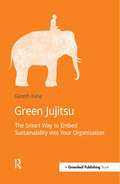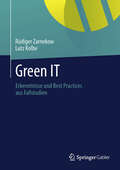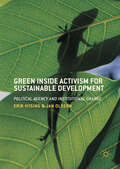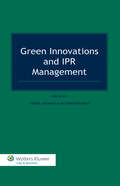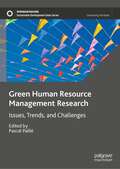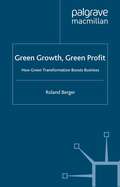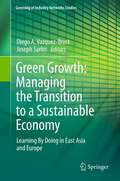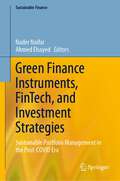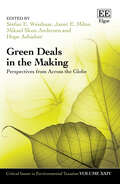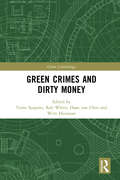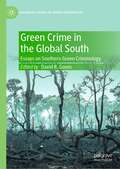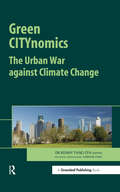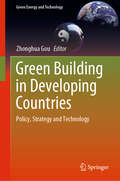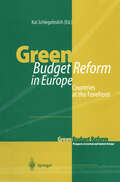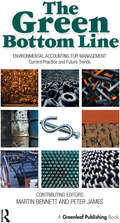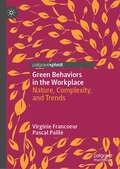- Table View
- List View
Green Jujitsu: The Smart Way to Embed Sustainability into Your Organization
by Gareth KaneBusiness has recently woken up to the need to address environmental sustainability in a meaningful way. No longer is it sufficient to have an environmental policy or environmental management system – substantial changes to business practice are required. Culture change is widely regarded as the most vital and the most difficult element of this paradigm shift. The standard methods of "switch it off" stickers, awareness presentations and proclamations from the top have proved incapable of delivering the shift in attitudes required. Green Jujitsu is a completely different way of looking at culture change for environmental sustainability. Instead of trying to correct your colleagues’ perceived "weaknesses", it focuses instead on playing to their strengths to get them truly interested and engaged. This principle is applied to the "elephant model" of culture change: providing clear guidance, inspiring people emotionally and altering the working environment. These techniques are illustrated with case studies from the author’s own experience of facilitating culture change on the front line in some of the world’s leading organizations.
Green Jujitsu: The Smart Way to Embed Sustainability into Your Organization (Doshorts Ser.)
by Gareth KaneBusiness has recently woken up to the need to address environmental sustainability in a meaningful way. No longer is it sufficient to have an environmental policy or environmental management system – substantial changes to business practice are required. Culture change is widely regarded as the most vital and the most difficult element of this paradigm shift. The standard methods of "switch it off" stickers, awareness presentations and proclamations from the top have proved incapable of delivering the shift in attitudes required. Green Jujitsu is a completely different way of looking at culture change for environmental sustainability. Instead of trying to correct your colleagues’ perceived "weaknesses", it focuses instead on playing to their strengths to get them truly interested and engaged. This principle is applied to the "elephant model" of culture change: providing clear guidance, inspiring people emotionally and altering the working environment. These techniques are illustrated with case studies from the author’s own experience of facilitating culture change on the front line in some of the world’s leading organizations.
Green IT: Erkenntnisse und Best Practices aus Fallstudien
by Rüdiger Zarnekow Lutz KolbeDie zunehmende Verbreitung und steigende Abhängigkeit von Informationstechnologien und darauf aufsetzender Dienste führen zu bisher unberücksichtigten ökologischen und sozialen Herausforderungen. Das IT-Management sieht sich aufgrund dieser Entwicklung mit neuen Anforderungen seitens der Geschäftsbereiche, der Kunden und der Mitarbeiter konfrontiert. Wachsender Energieverbrauch beim Betrieb und der Nutzung von IT-Infrastrukturen bei kontinuierlich steigenden Rechenleistungen sowie die immer kürzer werdenden Lebenszyklen von IT-Produkten erfordern neue strategische Konzepte für das IT-Management. Vor diesem Hintergrund werden in diesem Buch Best Practices im Bereich Green IT vorgestellt. Anhand von Fallstudien, die gemeinsam mit Autoren aus der Praxis verfasst wurden, sollen die Bedeutung und der Umsetzungsstand einer Nachhaltigkeitsorientierung im IT-Management aufgezeigt werden. In diesem Zusammenhang dokumentieren die Fallstudien aktuelle Bemühungen der Organisationen im Rahmen einer Green IT. Ziel des Buches ist es, IT-Organisationen anwendungsorientierte Konzepte und Modelle für die praktische Umsetzung zur Verfügung zu stellen.
Green Inside Activism for Sustainable Development: Political Agency and Institutional Change
by Erik Hysing Jan OlssonThis book considers how public sector institutions can be transformed to better support sustainable development by exploring the concept of green inside activism and its importance for institutional change. The phenomenon of inside activism has been shown to be crucial for green policy change and this book focuses on public officials as green inside activists, committed to green values and engaged in social movement, acting strategically from inside public administration to change public policy and institutions in line with such value commitment. The book theorizes how green inside activism can contribute to a more sustainable development through institutional change. This theorizing builds on and relates to highly relevant theoretical arguments in the existing literature. The authors also consider the legitimacy of inside activism and how it can be reconciled with democratic ideals. This innovative work will appeal to students and scholars of public policy, political science and environmental politics.
Green Innovations and IPR Management
by Andree Kirchner Iris Kirchner-FreisThere can no longer be any doubt that promoting green innovations is essential if we are to meet the challenges of sustainable development, climate change, and intergenerational equity. With the maturity of this crucial awareness has come full recognition of the intellectual property rights of green innovators – an area of international law that has drawn a host of initiatives not only from lawyers and legal scholars but also from highly knowledgeable and well-placed authorities such as the World Intellectual Property Organization, the European Patent Office, the United Nations Environment Program, the International Tribunal for the Law of the Sea, the International Centre for Trade and Sustainable Development, the European Commission, and national environmental agencies. In this first-ever survey and analysis of the current and emerging state of the field, twenty-two outstanding practitioners, academics, policymakers, and officials describe the relevant work of all of these groups. Among the array of topics covered are the following: vast diversity of products, services, and processes; legacy IP measures from R&D in computers and semiconductors; role of green technology’s moral underpinning; wide-open startup vs. exorbitant up-front cost; and licensing issues in technology transfer. Although primarily intended for professionals concerned with the legal aspects of green technology – lawyers, policymakers, agency officials, academics – this book will also be of great value to inventors and technology companies as a guide to mechanisms for managing and sharing intellectual property rights in the context of green innovations. It is sure to engage a wide audience for years to come.
Green Human Resource Management Research: Issues, Trends, and Challenges (Sustainable Development Goals Series)
by Pascal PailléIn contemporary times, most organizational functions (such as finance, marketing, and supply chains) have assessed their impact on the environment. HR has lagged behind other disciplines in discussions of sustainability, though the literature on this topic has grown significantly in recent years. This book, engaging SDGs 4 and 8, among others, examines green HRM from a variety of perspectives. Divided into three sections, it explores the process of human resource acquisition, the connection between green HRM practice and employee behavior, and international perspectives of green HRM. The final chapter presents a summary analysis of topics discussed in the book and outlines potential future paths of research for the field. This volume, featuring leading researchers from across the globe, further develops this emerging field for HR and organizational behavior scholars.
Green Harms and Crimes: Critical Criminology in a Changing World (Critical Criminological Perspectives)
by Ragnhild Aslaug SollundThe book presents discussions of the application of Stan Cohen's theories alongside empirical contributions in the fields of critical and green criminology. Taken together, the authors critically address harms and crimes against the environment, as well as against human and nonhuman victims.
Green Growth, Green Profit: How Green Transformation Boosts Business (International Management Knowledge)
by Roland Berger GmbHGreen business is here. It is a multi billion business with enormous growth potential, driven by megatrends such as demographic change, climate change and urbanization. It is driving the transformation of existing businesses and changing the way customers and suppliers act, forcing them to rethink their business strategy.
Green Growth: Learning By Doing in East Asia and Europe (Greening of Industry Networks Studies #1)
by Diego A. Vazquez-Brust and Joseph SarkisThis volume is a practical guide that helps the reader build a quick, evidence-based understanding of green-growth strategies and challenges. Its cogent analysis of real-life case studies enables policy makers and company executives identify successful strategies they can adopt, and pitfalls they can avoid, in drafting and implementing green growth policies. The contributors’ empirical assessment of these studies identifies the structural conditions required for economic growth to be compatible with environmental sustainability and how the transition to a new economic paradigm should be managed. A crucial addition to the debate now beginning in earnest around the world, this volume attempts to understand how we can nurture a new-born model of sustainable growth and help it evolve to maturity.
Green Finance Instruments, FinTech, and Investment Strategies: Sustainable Portfolio Management in the Post-COVID Era (Sustainable Finance)
by Nader Naifar Ahmed ElsayedIn the COVID 19 post-pandemic era, sustainable financial systems are increasingly getting the attention they deserve, and policymakers are now moving toward investment and financing decisions based on sustainable development. Green finance plays an important role in mobilizing financial resources and hedging against environmental risk to achieve financially sustainable systems. Moreover, green financial instruments offer viable alternatives for investors and regulators with regard to portfolio management and risk minimization. Over the last few years, financial technology (FinTech) has grown to become one of the most topical areas in the global financial services industry. The development of distributed ledger technology, big data, smart contracts, peer-to-peer lending platforms, biometrics, and new digital has sparked innovation in the financial services industry and the development of new financing and investment strategies. The combination of sustainability and FinTech can help policymakers to achieve ESG targets when making investment and financing decisions. This book showcases a collection of recent advances in green finance and FinTech and explores their impact in achieving sustainable finance, investment strategy-making, and portfolio management. Presenting theoretical frameworks and the latest empirical studies in the field of green finance and FinTech, it offers a valuable asset for academics, professionals, policymakers, regulators, and investors who want to understand in-depth the impact of green finance and FinTech on future investment and financing strategies in the post-pandemic era.
Green Events and Green Tourism: An International Guide to Good Practice
by Hugues Séraphin Emma NolanAs the appetite for leisure travel and events continues to grow at an exponential rate, the impact on the environment and local communities is becoming an increasing concern, not least by the users of the services. Green approaches to tourism and events are growing in popularity and present an opportunity to both identify solutions to significant environmental and societal problems and new approaches to business. Green Events and Green Tourism looks at key frameworks, guidelines, principles and benchmarks that support the application of sustainability in practice. The five sections of the book cover themes of governance, accreditation, certification, innovation, priorities, trends, ambitions and consumer behaviour, and the chapters include examples of best practice in the organisation of music and arts festivals, special interest tourism, the green management of outdoor sites and the management of sports events. Readers will benefit from insightful case studies from around the globe.
Green Events and Green Tourism: An International Guide to Good Practice
by Hugues Seraphin Emma NolanAs the appetite for leisure travel and events continues to grow at an exponential rate, the impact on the environment and local communities is becoming an increasing concern, not least by the users of the services. Green approaches to tourism and events are growing in popularity and present an opportunity to both identify solutions to significant environmental and societal problems and new approaches to business. Green Events and Green Tourism looks at key frameworks, guidelines, principles and benchmarks that support the application of sustainability in practice. The five sections of the book cover themes of governance, accreditation, certification, innovation, priorities, trends, ambitions and consumer behaviour, and the chapters include examples of best practice in the organisation of music and arts festivals, special interest tourism, the green management of outdoor sites and the management of sports events. Readers will benefit from insightful case studies from around the globe.
Green Deals in the Making: Perspectives from Across the Globe (Critical Issues in Environmental Taxation series)
Greenhouse gas concentrations are rapidly increasing and pathways to limit global warming require fundamental economic transitions. Green Deals in the Making addresses the challenges and opportunities associated with the implementation of Green Deals, in particular the use of market-based instruments.Expert contributors shed light on the complexities arising for the implementation of Green Deals in times of the context of the ongoing Covid-19 pandemic, which puts considerable strains on national economies. Chapters present theory and empirical analysis of green pricing instruments and national experiences, assessing the critical issue of finance and recycling carbon tax revenue. The book concludes with an analysis of key issues relating to circular economy considerations and plastics in achieving Green Deal goals. A critical analysis of important topics is presented including green fiscal reform, carbon taxation and sustainable urbanism.This timely book will be of great interest to researchers, students and scholars interested in environmental policy, tax and law, as well as the industry sector, policy makers and government officials.
Green Criminology (PDF)
by Nigel South Piers BeirneIn little more than a decade, Green Criminology has become an established new perspective in the field. It embraces an exciting and wide range of topics, from controversies about genetic modification through corporate offending against the environment and human communities, to animal abuse. Green Criminology provides a focal point for longstanding and new areas of research as well as making important interdisciplinary connections.
Green Criminology and the Law (Palgrave Studies in Green Criminology)
by James Gacek Richard JochelsonThis edited collection is grounded in a green criminological approach to understand whether the law, both in effect and implications, reflects, refracts, or sublimates the social, political and ecological conditions of our times. Since its initial proposal in the 1990s, green criminology has focused the criminological gaze on a wide array of harms and crimes affecting humans, animals other than humans, ecological systems, and the planet as a whole. As a continuously blossoming field of criminological inquiry, green criminology recognizes and examines behaviours that are both illegal and legal (yet detrimental), and in varying ways has made great efforts to provide insight into harms in a more fulsome manner. At the same time, there have been many significant legal instances, domestic, and international, including case law, legislation, regulation, treaties, agreements and executive directives which have troubled the law’s understanding of green harms, illegal and legal activity, pushing legal boundaries in the process. Recognizing that humanity and nature are inextricably integrated, Green Criminology and the Law reflects the range and depth of high-quality research and scholarship, combining contributions from established scholars willing to explore new topics and recent entrants who are breaking new scholarly ground.
Green Crimes and Dirty Money (Green Criminology)
by Toine Spapens Rob White Daan Van Uhm Wim HuismanEnvironmental crimes are primarily driven by financial motives. The combined financial value of illicit trade in protected wildlife, illegal logging and waste trafficking is estimated to come directly after counterfeiting, the narcotic drugs trade and illegal gambling. Logically, the proceeds of these crimes must also be laundered. Goods, however, are not the only money maker for environmental criminals. Corporations may also try to ‘save’ costs by not complying with environmental regulations and thus commit crimes of omission rather than commission. From an enforcement and compliance perspective focusing on the proceeds of crime may therefore be an effective strategy. This book brings together different perspectives on the financial aspects of environmental crime and harm from a green criminological viewpoint. It addresses the role of economic systems, the value of environmental performance for corporations, money laundering in the context of environmental crime, financial investigation and questions of regulation and penalties. Discussing these topics from the view of green criminology, sociology and governance, this book will be of great interest to all those concerned about the financial dimensions of crime and the environment.
Green Crimes and Dirty Money (Green Criminology)
by Toine Spapens, Rob White, Daan van Uhm and Wim HuismanEnvironmental crimes are primarily driven by financial motives. The combined financial value of illicit trade in protected wildlife, illegal logging and waste trafficking is estimated to come directly after counterfeiting, the narcotic drugs trade and illegal gambling. Logically, the proceeds of these crimes must also be laundered. Goods, however, are not the only money maker for environmental criminals. Corporations may also try to ‘save’ costs by not complying with environmental regulations and thus commit crimes of omission rather than commission. From an enforcement and compliance perspective focusing on the proceeds of crime may therefore be an effective strategy. This book brings together different perspectives on the financial aspects of environmental crime and harm from a green criminological viewpoint. It addresses the role of economic systems, the value of environmental performance for corporations, money laundering in the context of environmental crime, financial investigation and questions of regulation and penalties. Discussing these topics from the view of green criminology, sociology and governance, this book will be of great interest to all those concerned about the financial dimensions of crime and the environment.
Green Crime in the Global South: Essays on Southern Green Criminology (Palgrave Studies in Green Criminology)
by David R. GoyesThis book presents a socio-criminological study of environmental crime in the global South. It gathers contributors from all the regions of the geographical global South (Africa, Asia, Oceania, and Latin America) to discuss instances of environmental crime and conflict. Overall, it seeks to further decolonise the knowledge production of green criminology. It considers the legacy of colonisation, North-South and the core-periphery divides in the production of environmental crime, the epistemological contributions of the marginalised, impoverished, and oppressed, and the unique contexts of the global South. This book has three sections: drivers of green crime in the global South; responses to environmental harm in the global South; and global dialogues about crime and destruction in the global South. The first two sections represent the breadth of the topics that green criminologists have historically studied but from unique perspectives. The third section explores ethical and decolonial ways for Southern green criminology to collaborate with Western academia. This book speaks to scholars in criminology, political ecology, decolonial theory, along with the many readers interested in the interactions between humans and nature.
Green CITYnomics: The Urban War against Climate Change
by Kenny TangToday, more than half of the world's population are living in cities that are now contributing 80% of global greenhouse gas emissions. They cover less than 3% of the earth's surface. And urbanization continues apace. With such a massive carbon footprint, it is vital that cities are part of the solution. Despite this, scarcely any consideration has been given to the potential impact of climate change on urban dwellers, especially in the developing countries and burgeoning megacities of Africa, Asia and Latin America, where a wide variety of environmental and development challenges are likely to further exacerbate their vulnerability to climatic effects. Green CITYnomics presents a rich set of contributions by a highly diverse group of 45 of the world's leading urban experts on climate change. In particular, it illustrates the desire some cities are already demonstrating in engaging in this war. Standing still is not an option. Budgets have to be fought for; minds have to be won over; old, untenable and unsustainable ideas and solutions must be challenged; green and sustainable solutions must be given the chance to develop and to prove themselves. Each of the cities and urban centres discussed – from Hong Kong to Dresden; from Mexico City to Qatar – are, in their own ways, heroes and examples to us all. This book provides a compelling manifesto for the world's cities in their "Urban War against Climate Change". It is essential reading for climate scientists, national and local policy-makers and scholars worldwide.
Green CITYnomics: The Urban War against Climate Change
by Kenny Tang Lorraine TangToday, more than half of the world's population are living in cities that are now contributing 80% of global greenhouse gas emissions. They cover less than 3% of the earth's surface. And urbanization continues apace. With such a massive carbon footprint, it is vital that cities are part of the solution. Despite this, scarcely any consideration has been given to the potential impact of climate change on urban dwellers, especially in the developing countries and burgeoning megacities of Africa, Asia and Latin America, where a wide variety of environmental and development challenges are likely to further exacerbate their vulnerability to climatic effects. Green CITYnomics presents a rich set of contributions by a highly diverse group of 45 of the world's leading urban experts on climate change. In particular, it illustrates the desire some cities are already demonstrating in engaging in this war. Standing still is not an option. Budgets have to be fought for; minds have to be won over; old, untenable and unsustainable ideas and solutions must be challenged; green and sustainable solutions must be given the chance to develop and to prove themselves. Each of the cities and urban centres discussed – from Hong Kong to Dresden; from Mexico City to Qatar – are, in their own ways, heroes and examples to us all. This book provides a compelling manifesto for the world's cities in their "Urban War against Climate Change". It is essential reading for climate scientists, national and local policy-makers and scholars worldwide.
Green Building in Developing Countries: Policy, Strategy and Technology (Green Energy and Technology)
by Zhonghua GouThe book reveals how green buildings are currently being adapted and applied in developing countries. It includes the major developing countries such as China, Indonesia, Malaysia, Thailand, Pakistan, Cambodia, Ghana, Nigeria and countries from the Middle East and gathers the insights of respected green building researchers from these areas to map out the developing world’s green building revolution. The book highlights these countries’ contribution to tackling climate change, emphasising the green building benefits and the research behind them.The contributing authors explore how the green building revolution has spread to developing countries and how national governments have initiated their own green building policies and agendas. They also explore how the market has echoed the green building policy, and how a business case for green buildings has been established. In turn, they show how an international set of green building standards, in the form of various techniques and tools, has been incorporated into local building and construction practices. In closing, they demonstrate how the developing world is emerging as a key player for addressing the energy and environmental problems currently facing the world.The book helps developers, designers and policy-makers in governments and green building stakeholders to make better decisions on the basis of global and local conditions. It is also of interest to engineers, designers, facility managers and researchers, as it provides a holistic picture of how the industry is responding to the worldwide call for greener and more sustainable buildings.
Green Budget Reform in Europe: Countries at the Forefront
by Kai SchlegelmilchBudgets have a big influence on the economy and society. With many countries, about 50 percent of total expenditures and income pass through the budget via taxes, charges and expenditures. In recent years many countries, e. g. in the OECD and the EU, have tended to use this influence in an environmentally rational way. Tradi tional environmental policy has relied on command-and-control and cnd-olpipc technologies that have proven to be insufficient in coping with the challenge of glo bal change. Hence, many countries have started to investigate the environmental impacts of their budgets by looking at existing taxes and charges, as well as tax allowances and exemptions and other relevant regulations and expenditures -even to have a special impact on the environment. The implementation of those not meant such findings is now broadly discussed in these countries. This publication will contribute to the debate. It is a result of a wider project called Green Budget Reform -Prospects in Central and Eastern Europe. initiated by Vida Ogorelec Wagner, managing Director of Umanotera, The Sloven ian Founda tion for Sustainable Development, and then jointly developed. proposed to the EC and carried out in partnership with Kai Schlegelmich of the Wuppertal Institute in Germany. The project comprised an international seminar on Green Budget Reform in April 1997 at Lake Bled, Slovenia, and the Case Study of Sloveilla.
The Green Bottom Line: Environmental Accounting for Management: Current Practice and Future Trends
by Martin Bennett Peter JamesTo date, both internal and external corporate environmental reporting and management systems have focused on physical input–output measures. However, external stakeholders are increasingly demanding that organisations provide more financial information about the costs and benefits of their environmental actions. As environmental costs rise, internal decision-makers are also seeking such information to ensure that money is well spent. Beyond basic compliance, many companies will not countenance environmental actions for which a "business case" cannot be made. A number of companies – such as Baxter, BT, Xerox, Zeneca and others – are now beginning to develop a better understanding of the costs and benefits of environmental action. The US Environmental Protection Agency has also done considerable work on models designed to understand the "full costs" of pollution control investments, with the aim of demonstrating that – when these are properly considered – pollution prevention can be a more cost-effective alternative. The Green Bottom Line brings together much of the world's leading research and best-practice case studies on the topic. Divided into four sections, covering "General Concepts", "Empirical Studies", "Case Studies" and "Implementation", the book includes case studies from the US EPA's Environment Accounting Programme and contributions from authors at institutions including the IMD, INSEAD, Tellus Institute and the World Resources Institute. It constitutes a state-of-the-art collection.
The Green Bottom Line: Environmental Accounting for Management: Current Practice and Future Trends
by Martin Bennett Peter JamesTo date, both internal and external corporate environmental reporting and management systems have focused on physical input–output measures. However, external stakeholders are increasingly demanding that organisations provide more financial information about the costs and benefits of their environmental actions. As environmental costs rise, internal decision-makers are also seeking such information to ensure that money is well spent. Beyond basic compliance, many companies will not countenance environmental actions for which a "business case" cannot be made. A number of companies – such as Baxter, BT, Xerox, Zeneca and others – are now beginning to develop a better understanding of the costs and benefits of environmental action. The US Environmental Protection Agency has also done considerable work on models designed to understand the "full costs" of pollution control investments, with the aim of demonstrating that – when these are properly considered – pollution prevention can be a more cost-effective alternative. The Green Bottom Line brings together much of the world's leading research and best-practice case studies on the topic. Divided into four sections, covering "General Concepts", "Empirical Studies", "Case Studies" and "Implementation", the book includes case studies from the US EPA's Environment Accounting Programme and contributions from authors at institutions including the IMD, INSEAD, Tellus Institute and the World Resources Institute. It constitutes a state-of-the-art collection.
Green Behaviors in the Workplace: Nature, Complexity, and Trends
by Virginie Francoeur Pascal PailléThis book examines the spectrum of green behaviors in organizational settings, focusing on the contribution that employees make through their environmental engagement. The authors provide an overview of green behaviors while clarifying the meaning of the concept and its critical importance to greening employees. By distinguishing between voluntary (e.g., encouraging colleagues to express their ideas about environmental issues), prescribed (e.g., having an obligation to implement environmental policies), and counterproductive (e.g., not caring about water or electricity consumption) behaviors, the book rethinks sustainable development, placing the psychological and environmental dimensions on a par.Aimed at researchers in human resource management, organizational behavior, organizational change, and psychology, this interdisciplinary study proposes a novel approach to sustainability by assessing employee behaviors at work.
